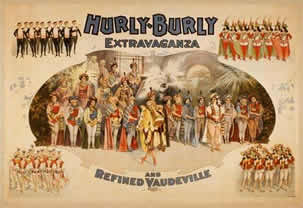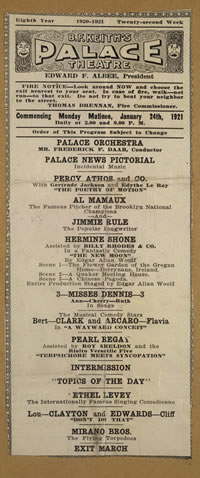Vaudeville
 Vaudeville was an extremely popular form of entertainment in the United States between the 1890s and the 1930s. The relationship between the movies and vaudeville was critical in several ways:
Vaudeville was an extremely popular form of entertainment in the United States between the 1890s and the 1930s. The relationship between the movies and vaudeville was critical in several ways:
First, most of the earliest films were films of vaudeville acts.
Second, the form of early movie going experience was based on vaudeville (and, many times, films were shown as part of vaudeville).
Third, a great many film stars of the first half of the 20th century started in vaudeville. These include the Marx Brothers, Buster Keaton, Bob Hope, Bud Abbott, Mae West, Judy Garland, and many, many others.
So, what was Vaudeville?
Vaudeville was a uniquely American art form. However, it was related to both earlier American mistral shows and to the British Music Hall tradition. The word "vaudeville" almost certainly comes from the French, "voix de ville" (voice of the town). But, the French tradition was different.
 A vaudeville show consisted of a series of acts like those appearing in the poster shown at the left. This is an actual play bill for a vaudeville show that was given at one of the premier vaudeville theaters in New York City in January 1921. Acts ranged in length from about 6 minutes to about 15 minutes, making the whole experience, including the intermission about two hours long. Let's look at what people saw.
A vaudeville show consisted of a series of acts like those appearing in the poster shown at the left. This is an actual play bill for a vaudeville show that was given at one of the premier vaudeville theaters in New York City in January 1921. Acts ranged in length from about 6 minutes to about 15 minutes, making the whole experience, including the intermission about two hours long. Let's look at what people saw.
The first act was a musical introduction by the theater's house orchestra.
Second came a newsreel...a movie, probably about 10 minutes long, that showed pictures of current world events. Since this was still in the silent era, there was musical accompaniment, but no narration.
Then came Percy Athos and Company. Athos was a well known British cabaret producer and this would almost certainly been a song and dance number.
The fourth act was Al Mamaux. Mamaux (1894-1963) (pronounced ma-MOO) was a baseball pitcher for the Pittsburgh Pirates and the Brooklyn Robins. Sports stars were common attractions of vaudeville shows. In the early 20th century, they didn't make much money and they had half the year off. Sometimes their appearance was enough. More often they told stories or sang. Babe Ruth was a frequent vaudeville attraction. Here's about 30 seconds of him singing (terribly...not required.). Mamaux was a singer, sometimes billed as "Golden Voice Tenor" and he played the violin. He appeared with Jimmie Rule, a singer songwriter.
Then there was a three scene comic play starring Hermine Shone and written by Edgar Allan Woolf (1881-1943). Shone traveled with several others acting in brief comic plays. Woolf later became a script writer for MGM. He contributed to numerous movies. Most notably, he's credited as one of the screen writers on The Wizard of Oz.
This was followed by another musical number with The Three Misses Dennis"
The sixth act was Bert Clark (1873-1932) and Flavia Arcaro (1876-1937), stars of musical comedy doing "A Wayward Conceit" Clark was an English performer who also worked at Mack Sennett's Keystone Studios and partnered with Charlie Chaplin in a music publishing company. Arcaro (from Mejico TX) was in a dozen films between 1915 and 1934. "A Wayward Conceit" was a "famous travesty" starring Clark as "Lord Helpus" described as "a broken-down Britisher with a shabby frock coat and a champaign appetite."
Next came Pearl Regay, a Broadway dancer with Roy Sheldon and the "Rialto Versatile Five" a jazz band. Sheldon also had a career as an actor and director.
Then it was time for intermission.
After Intermission it was "Topics of the Day" I'm not sure what this was but it was fairly common to have a comic monologue on news items. Here, there's no name connected to the presentation. It could be another newsreel.
Then came Ethel Levey (1881-1955). Levey was really the star attraction in this presentation. That's why she appears after the intermission. She was a Broadway star, a high-kick dancer and a singer. She was sometimes known as the "Queen of Ragtime." Levey had been married to George M. Cohan (1878-1942), one of the most famous entertainers of the early 20th century. Cohan came from a vaudeville family, whose act was called "The Four Cohans." Levey had been a member of the group after Cohan's sister married and left the act. Levey appeared in numerous George M. Cohan productions. BTW, you may not know that you know George M. Cohan's work, but you certainly do. He wrote over 300 songs including "Yankee Doodle," "Give My Regards to Broadway," "You're a Grand Old Flag," and "Over There." In the somewhat less likely event that you've ever said something like "Ladies and gentlemen, my mother thanks you, my father thanks you, my sister thanks you, and I thank you" that too is a Cohan quote (it was the end of the Four Cohans act). BTW, Cohan and Levey sound like they might have been Jewish...but neither was. You can hear what Levey sounded like by clicking here (optional).
Next up Lou Clayton and Cliff Edwards...both major attractions. Clayton (1890-1950) and Edwards (1895-1971), who was also known as "Ukulele Ike" did jazzy versions of popular tunes and played their own original music. Both were among the biggest vaudeville stars when they appeared in this show and both went on to long careers. Clayton left Edwards to team up with Jimmy Durante and Eddie Jackson in an act called "The Three Sawdust Bums." He eventually became Durante's partner and manager. He appeared in one Hollywood film. You are far more likely to know Cliff Edwards' work. After leaving Clayton, Edwards worked with George and Ira Gershwin. He made the famous recordings of "I Can't Give You Anything But Love" (hear it here, optional) and "Singin In The Rain." (hear it here, optional). You probably haven't heard those before. However, Edwards also did voices for animated films, most notably Walt Disney's Pinocchio (1940). He was the voice of Jiminy Cricket. This one you've heard (optional).
This was followed by The Mirano Brothers. They were three Italian naval officers who did a trapeze act. They may not have been particularly good. It was common for vaudeville houses to use a mediocre act to end the show. Owners wanted to get the customers out and giving them something the wouldn't like much after the stars got to perform was a way to clear the house.
Then, the whole thing concluded with a grand march.
Next: Vaudeville Circuits